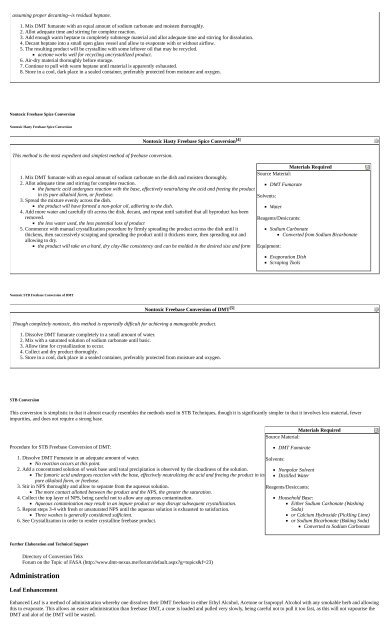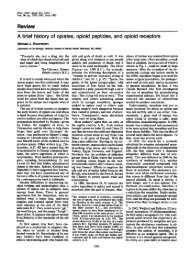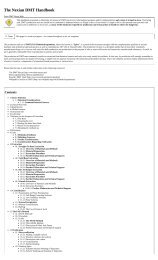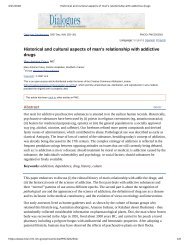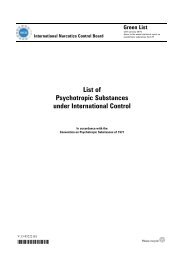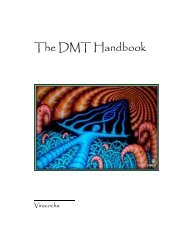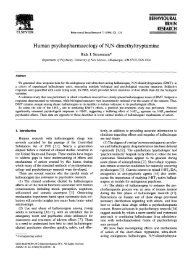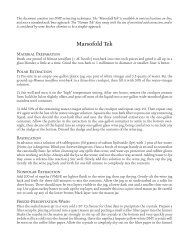The Nexian DMT Handbook - DMT-Nexus Wiki
The Nexian DMT Handbook - DMT-Nexus Wiki
The Nexian DMT Handbook - DMT-Nexus Wiki
You also want an ePaper? Increase the reach of your titles
YUMPU automatically turns print PDFs into web optimized ePapers that Google loves.
assuming proper decanting--is residual heptane.<br />
1. Mix <strong>DMT</strong> fumarate with an equal amount of sodium carbonate and moisten thoroughly.<br />
2. Allot adequate time and stirring for complete reaction.<br />
3. Add enough warm heptane to completely submerge material and allot adequate time and stirring for dissolution.<br />
4. Decant heptane into a small open glass vessel and allow to evaporate with or without airflow.<br />
5. <strong>The</strong> resulting product will be crystalline with some leftover oil that may be recycled.<br />
acetone works well for recycling uncrystallized product.<br />
6. Air-dry material thoroughly before storage.<br />
7. Continue to pull with warm heptane until material is apparently exhausted.<br />
8. Store in a cool, dark place in a sealed container, preferably protected from moisture and oxygen.<br />
Nontoxic Freebase Spice Conversion<br />
Nontoxic Hasty Freebase Spice Conversion<br />
Nontoxic Hasty Freebase Spice Conversion [4]<br />
This method is the most expedient and simplest method of freebase conversion.<br />
1. Mix <strong>DMT</strong> fumarate with an equal amount of sodium carbonate on the dish and moisten thoroughly.<br />
2. Allot adequate time and stirring for complete reaction.<br />
the fumaric acid undergoes reaction with the base, effectively neutralizing the acid and freeing the product<br />
in its pure alkaloid form, or freebase.<br />
3. Spread the mixture evenly across the dish.<br />
the product will have formed a non-polar oil, adhering to the dish.<br />
4. Add more water and carefully tilt across the dish, decant, and repeat until satisfied that all byproduct has been<br />
removed.<br />
the less water used, the less potential loss of product<br />
5. Commence with manual crystallization procedure by firmly spreading the product across the dish until it<br />
thickens, then successively scraping and spreading the product until it thickens more, then spreading out and<br />
allowing to dry.<br />
the product will take on a hard, dry clay-like consistency and can be molded in the desired size and form<br />
Materials Required<br />
Source Material:<br />
Solvents:<br />
<strong>DMT</strong> Fumarate<br />
Water<br />
Reagents/Desiccants:<br />
Equipment:<br />
Sodium Carbonate<br />
Converted from Sodium Bicarbonate<br />
Evaporation Dish<br />
Scraping Tools<br />
Nontoxic STB Freebase Conversion of <strong>DMT</strong><br />
Nontoxic Freebase Conversion of <strong>DMT</strong> [5]<br />
Though completely nontoxic, this method is reportedly difficult for achieving a manageable product.<br />
1. Dissolve <strong>DMT</strong> fumarate completely in a small amount of water.<br />
2. Mix with a saturated solution of sodium carbonate until basic.<br />
3. Allow time for crystallization to occur.<br />
4. Collect and dry product thoroughly.<br />
5. Store in a cool, dark place in a sealed container, preferably protected from moisture and oxygen.<br />
STB Conversion<br />
This conversion is simplistic in that it almost exactly resembles the methods used in STB Techniques, though it is significantly simpler in that it involves less material, fewer<br />
impurities, and does not require a strong base.<br />
Materials Required<br />
Source Material:<br />
Procedure for STB Freebase Conversion of <strong>DMT</strong>:<br />
<strong>DMT</strong> Fumarate<br />
1. Dissolve <strong>DMT</strong> Fumarate in an adequate amount of water.<br />
No reaction occurs at this point.<br />
2. Add a concentrated solution of weak base until total precipitation is observed by the cloudiness of the solution.<br />
<strong>The</strong> fumaric acid undergoes reaction with the base, effectively neutralizing the acid and freeing the product in its<br />
pure alkaloid form, or freebase.<br />
3. Stir in NPS thoroughly and allow to separate from the aqueous solution.<br />
<strong>The</strong> more contact allotted between the product and the NPS, the greater the saturation.<br />
4. Collect the top layer of NPS, being careful not to allow any aqueous contamination.<br />
Aqueous contamination may result in an impure product or may disrupt subsequent crystallization.<br />
5. Repeat steps 3-4 with fresh or unsaturated NPS until the aqueous solution is exhausted to satisfaction.<br />
Three washes is generally considered sufficient.<br />
6. See Crystallization in order to render crystalline freebase product.<br />
Solvents:<br />
Nonpolar Solvent<br />
Distilled Water<br />
Reagents/Desiccants:<br />
Household Base:<br />
Either Sodium Carbonate (Washing<br />
Soda)<br />
or Calcium Hydroxide (Pickling Lime)<br />
or Sodium Bicarbonate (Baking Soda)<br />
Converted to Sodium Carbonate<br />
Further Elaboration and Technical Support<br />
Directory of Conversion Teks<br />
Forum on the Topic of FASA (http://www.dmt-nexus.me/forum/default.aspx?g=topics&f=23)<br />
Administration<br />
Leaf Enhancement<br />
Enhanced Leaf is a method of administration whereby one dissolves their <strong>DMT</strong> freebase in either Ethyl Alcohol, Acetone or Isopropyl Alcohol with any smokable herb and allowing<br />
this to evaporate. This allows an easier administration than freebase <strong>DMT</strong>, a cone is loaded and pulled very slowly, being careful not to pull it too fast, as this will not vapourise the<br />
<strong>DMT</strong> and alot of the <strong>DMT</strong> will be wasted.


